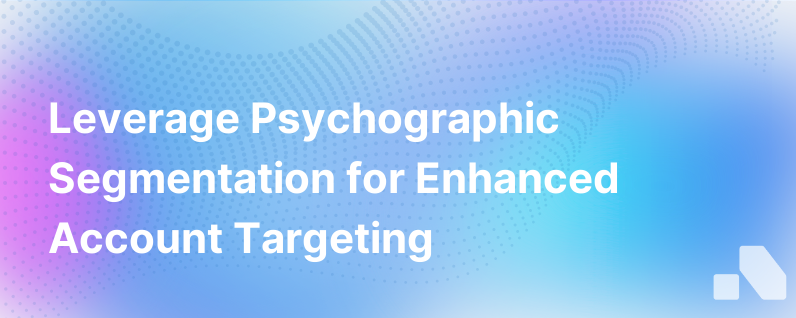What Is Psychographic Segmentation And How Can It Improve Account Targeting And Conversions
Published on August 17, 2023 by Sawyer Middeleer
Psychographic segmentation is a method used to divide a market into segments based on the psychological attributes of consumers, including their personality traits, values, attitudes, interests, and lifestyles. Unlike demographic or geographic segmentation, psychographics identify more intrinsic qualities of a consumer, digging deeper into the 'why' behind their purchasing behaviors. Employing psychographic segmentation in B2B sales leads to a nuanced understanding of potential leads and customers, allowing sales teams to target accounts with greater precision and nurture leads toward conversion more effectively.
Understanding the Consumer At the heart of psychographic segmentation is the pursuit of a holistic understanding of your potential buyer. Demographics tell us 'who' the buyer is in terms of age, occupation, or gender, while psychographics illuminate the 'why' behind their actions—offering deeper insights into their routine behaviors and motivations. This method provides context to the purchasing progression, allowing a business to align its sales and marketing strategies more closely with the idiosyncrasies of its consumers.
How Psychographic Segmentation Bolsters Account Targeting Tailoring Interactions Using psychographics, sales teams can categorize prospects based on their aspirations, challenges, and habits. This allows for highly personalized interactions—whether through email campaigns, social media, or direct sales pitches—that resonate with the prospects’ own outlook and preferences, fundamentally increasing the chances of engagement.
Optimizing Value Propositions Understanding the personality and values of a prospect can significantly help in refining the value proposition that a business offers. For B2B scenarios, where a purchasing decision can be influenced by factors like corporate culture or leadership vision, aligning the value proposition with these psychographic elements can create compelling reasons for prospects to choose your product over competitors.
Strengthening Customer Relationships Psychographic segmentation paves the way for more meaningful relationships, as businesses can provide content, solutions, and experiences tailored to prospects' values and interests. This approach translates to a deeper connection with the brand and often leads to customer loyalty and advocacy.
Maximizing Resource Allocation Marketing and sales resources are finite. By prioritizing accounts with psychographic characteristics that align best with your offering, your resources are utilized more effectively, leading to higher conversion rates and ROI. This also supports account-based marketing efforts, which rely on personalized and focused approaches for high-value accounts.
Psychographics in Action To effectively apply psychographic segmentation, a robust data collection strategy is essential. Sales and marketing teams must gather information through various touchpoints — surveys, interviews, social media interactions, and behavioral analytics—to paint a comprehensive picture of their consumer psyche.
Example Segments For instance, if the target market includes corporate buyers, the psychographic segments might be categorized as follows:
- Innovation Seekers: Businesses that prioritize being at the forefront of their industry might be more interested in new, cutting-edge solutions. Sales strategies for these accounts should focus on innovation, industry leadership, and technological advancements.
- Value Maximizers: Other accounts may be more cost-conscious or focused on long-term profitability. For these segments, sales strategies should emphasize ROI, cost-effectiveness, and comprehensive service offerings.
- Sustainability Advocates: If a prospect places a high value on corporate responsibility and sustainable practices, your sales pitch could spotlight eco-friendly aspects of your product or your company's larger commitment to sustainability.
Implementing Psychographics Knowledge of these psychographic profiles can then be applied in multiple stages of the sales funnel:
- Lead Qualification: By assessing leads against psychographic criteria, teams can prioritize leads that not only fit the demographic and firmographic profile but are also aligned with the psychological and cultural profile of the ideal customer.
- Content Marketing: Create content that appeals to the specific interests and values of each psychographic segment. This could range from thought leadership on industry innovation for 'Innovation Seekers' to case studies highlighting efficiency and ROI for 'Value Maximizers'.
- Sales Pitches and Presentations: Customize your pitch to address the unique challenges and goals of each psychographic segment. Sales representatives can undergo training to recognize and adapt to different buyer personas in real-time.
- Product Development: Feedback and insights gained from psychographic segmentation can inform product development to ensure your offerings cater to the nuanced needs of your market.
Challenges and Considerations While psychographic segmentation is invaluable, it does present challenges. Firstly, collecting psychographic data is more complex than demographic or firmographic data, often requiring more nuanced analysis. Secondly, accurately interpreting this data to inform strategy requires a degree of psychological insight, which may necessitate more specialized training or personnel.
Conclusion When integrated into the account targeting strategy, psychographic segmentation equips sales teams with a deeper understanding of their prospects. It enhances personalization efforts, sharpens sales pitches, and directs valuable resources toward the most receptive audiences, ultimately driving higher conversion rates and cementing long-term customer relationships. As data-driven approaches to B2B sales become more sophisticated, psychographic segmentation stands out as a key component in the evolution of customer-centric sales tactics, ensuring that your messages resonate at the most personal level with your potential accounts.